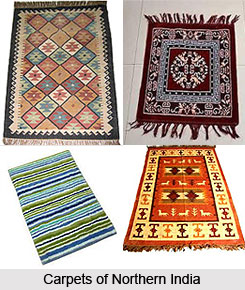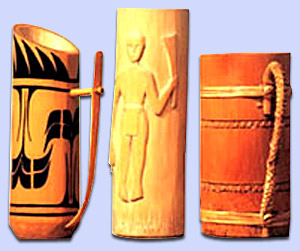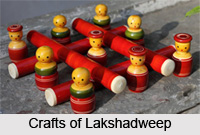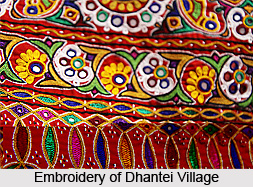 Carpets of Northern India bring to the fore the Handicraft or crafts works which is regionally based in North India and is popular for its aestheticism, attractive decor and usefulness. By the use of hands and simple tools these carpets are weaved and what takes place is the birth of beautiful and useful decorative devices. The art of handicraft in India dates back to Indus Valley Civilisation, from where it actually commenced and is continuing till date. The North India Handicrafts which consists of the states of Haryana, Punjab, Himachal Pradesh, Rajasthan, Jammu and Kashmir and Chandigarh even are deft in the art of weaving carpets. Carpets of Uttar Pradesh are particularly known all across the globe for its unique colours and designs. Employment in Uttar Pradesh constitutes almost 90 % of the carpet weavers. Bhadohi, Mirzapur and Agra are the major carpet hubs in Uttar Pradesh. Among these places, Bhadohi enjoys worth special mention as the economy of this district and its 500 odd villages are completely dependent upon the carpet business.
Carpets of Northern India bring to the fore the Handicraft or crafts works which is regionally based in North India and is popular for its aestheticism, attractive decor and usefulness. By the use of hands and simple tools these carpets are weaved and what takes place is the birth of beautiful and useful decorative devices. The art of handicraft in India dates back to Indus Valley Civilisation, from where it actually commenced and is continuing till date. The North India Handicrafts which consists of the states of Haryana, Punjab, Himachal Pradesh, Rajasthan, Jammu and Kashmir and Chandigarh even are deft in the art of weaving carpets. Carpets of Uttar Pradesh are particularly known all across the globe for its unique colours and designs. Employment in Uttar Pradesh constitutes almost 90 % of the carpet weavers. Bhadohi, Mirzapur and Agra are the major carpet hubs in Uttar Pradesh. Among these places, Bhadohi enjoys worth special mention as the economy of this district and its 500 odd villages are completely dependent upon the carpet business.
The specialty of Bhadohi carpets of Uttar Pradesh is their individual designs. These designs have been developed by the native weavers and also include various tints of Taj Mahal in natural colour or Sirdar in subdued colours. The carpets of Uttar Pradesh come with hand imprinted or hand carved borders in rose-beige, honey, ivory and Iraq green. Another popular design of the carpets made in Uttar Pradesh is called `sculpture design` that uses clippings of the thread around the helm and gives it a 3-dimensional texture. Mostly bright coloured pastel shades are used in this 18th century design pattern.
Agra in Uttar Pradesh was the first carpet centre in the Mughal India. A very interesting system is followed here that has been oddly named `Calling Out` system. In this system the master weaver of carpets of Uttar Pradesh follows the design and keeps calling out to the weavers the colours to be used for each knot. The Iranian weavers took the real initiative of carpet weaving in Uttar Pradesh. Their designs besides the high quality of Cashmere wool resulted in the prosperity of Indian carpet. Presently, Uttar Pradesh is one of the most important centres in silk carpet exports and the general design of carpets in Uttar Pradesh is a combination of Iranian, Moroccan, French and Turkmen designs that are drawn by local designers and woven by weavers. Some of the famous designs are named after cities and provinces of Iran such as Sarough, Tabriz, Hamadan, Kashan, Isfahan and Khorasan. Mirzapur, Badohi, and Khamaria are the main towns boasting trained carpet weavers who produce the unique carpets of Uttar Pradesh.
Twisted cotton thread is used along with the Jute twine thus giving rougher qualities of carpet with about 60 knots per square inch. Cotton and woollen carpets are mainly manufactured in Shahjehanpur and Agra where weavers produce long-established and also new motifs, keeping the market demand in mind.
The hand knotted silk and woollen carpets of Kashmir take pride in their uniqueness. The carpet producing centres in India is mostly present in Kashmir, who is the traditional hand knotted silk carpet weavers. The origins of the traditional silk carpets of Kashmir can be traced to the Mughal period.
Hand knotted pure silk carpets of Kashmir are world famous for their softness and craftsmanship. These carpets are very expensive. The process of creating a hand knotted silk carpet is lengthy and requires a lot of preparation by the craftsman before weaving the carpet. The yarn used in making these carpets determines the type of the carpet to be created. Woollen carpets of Kashmir are always created on a cotton base with woolen yarn. Silk yarn is sometimes used in woollen carpets as highlights on certain designs and motifs. A carpet with a pure silk pile may be referred to as an 80% silk carpet. Carpet weaving in Kashmir was not originally indigenous but is thought to have come in by way of Persia. Atypical Kashmiri design is the tree of life. Persian design not withstanding, any carpet woven in Kashmir is referred to as Kashmiri. The colour-way of Carpet and its details differentiate it from any other carpet. And while on the subject of colours, it should be kept in mind that although the colours of Kashmiri carpets are more subtle and muted than elsewhere in the country, only chemical dyes
Hand silk carpets of Kashmir are the specialties. They are those carpets, which are created on a silk pile and the silk carpets are also created on a cotton or woollen pile. Generally silk carpets are made up of 80% of silk yarn and 20% of cotton yarn, having more than 400 knots per square inch. 100% pure silk carpets have very high knots per inch. The knots per square inch of such carpet can vary between 400-1600 knots per square inch. The knotting of the carpet is the most important aspect, determining its durability and value, in addition to its design. Basically, the more knots per square inch, the greater its value and durability. The carpet craftsmen in Kashmir follow the traditional Persian or Islamic designs of Kirman, Kashan, and Esfahan, Herat and so on to weave their innovative carpets. Though there is a strong Persian influence in Kashmiri carpets, however one can also see local variations.
The most recurring motif of carpets of Kashmir, found on silk carpets from Kashmir is the depiction of the tree of life, in all its glory. The natural beauty of Kashmir and its picturesque views has also inspired the carpet weavers and the locale has also become a theme of Kashmiri carpets. Other popular themes of carpets of Kashmir include hunting scenes, bird and animal motifs and significant themes. These carpets are available in a variety of colours and designs. Carpets from Kashmir are subtle in comparison with the carpets woven from other parts of the country. Carpets made in Kashmir are made with fibre dyed with mineral colours, as vegetable dyes are not used at all. Bright colours like red, blue and yellow colour are also used.
Kashmir has been the centre of arts and crafts since many centuries. The Kashmir carpets are celebrated worldwide. The mesmerizing beauty of the carpets reflects the beauty of the place itself. Mughals mastered this art in India and the carpet weaving initially was very much influenced by the Persian designs, styles and patterns. However in the late seventeenth century, Indian style began to replace the Persian style in regard to the carpets motifs. In the modern period Kashmir carpets especially those manufactured from silk are the most admired as floor covering items in the world. The colours of the Kashmir carpet distinguish it from the other carpets. The carpet colours are more restrained and muted. Vegetable dyes are mainly used for colouring the yarn and all shades of red, green, yellow, blue are used principally.
The yarns used in carpets of Kashmir are either silk or wool or sometimes a combination of the two. The pile used is usually and generally wool. While manufacturing woollen carpets, cotton is used as base; silk carpets may have a cotton or silk base. As compared to woollen carpets silk carpets are expensive. Sometimes silk is used in the woollen carpets for extra polish. Woolen carpets of Kashmir are soft and make thinner folds; they are more flexible and have the shine of the silk. The knots per square inches in these carpets are high. Silk Kashmir carpets have a diverse sheen with velvety soft touch.
The knots in Kashmiri carpets determine the durability and the strength of the Kashmir carpet. Kashmiri carpets are often woven with either double knots or with single knot. As compared to double-knotted carpets, single knotted carpets are fluffier. The double-knotted carpet pile is less resistant to touch and pressure. Carpets of Kashmir are marvellous pieces of art and lend beauty to the whole environment if installed in homes. Carpets are beautified by elaborate patterns and marvellous designs. The most popular designs of these carpets are the tree of life. Designs of these carpets are mainly floral or zoological though geometrical motifs. The designs of these carpets are named after Iranian cities like Kashan, Kirman, Ardabil, Meshad, Qum, Faraghan, Hamadan and so on. The carpet weaving technique used in Kashmir is called Talim. It is a blueprint of carpet weaving. It is paper that is covered with interminable rows of twists, curves and hieroglyphs. After learning the design depicted on the Talim for months, the actual manufacturing starts.
While buying carpets of Kashmir, one should keep in mind certain things. As these carpets are very expensive and is one time investment, they must keep following things in mind before purchasing Kashmir carpets. The material of the carpet should be checked properly and a close eye should be given on the carpet that is being purchased and enquire the knotting pattern just seeing the carpet from the reverse side. Each motif or element of design should have clear, crisp outlines and the edges should also be smooth. The carpets of Kashmir are famous all across the world and are largely exported to other foreign countries.






